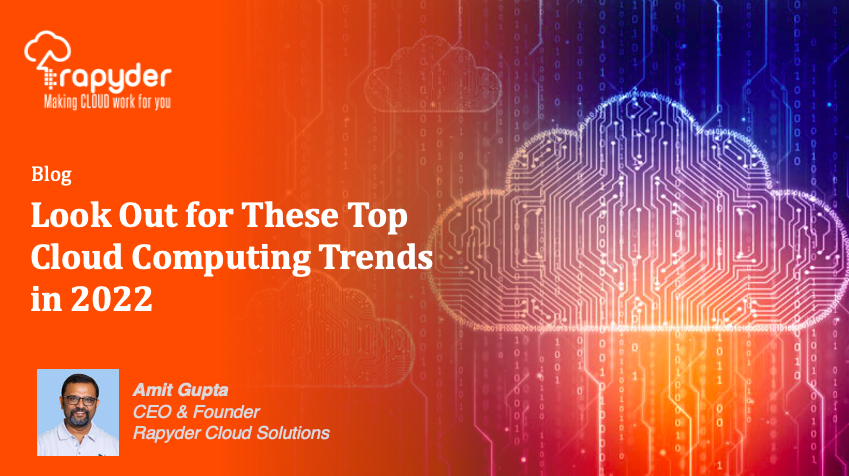Look Out for These Top Cloud Computing Trends in 2022 - Amit Gupta, CEO & Founder, Rapyder Cloud Solutions

The year 2020 and 2021 allowed cloud computing to grow multifold as work and businesses adapted to the global pandemic. In 2022, cloud computing is definitely projected to grow rapidly. The trend is definitely going to see an upgrade in terms of adopting holistic strategies entered around enterprise-wide cloud migration. The gradual shift from zoom meetings to deployment of cloud tools in order to improve specific functions is definitely foreseen.
From reshaping cloud service provider (CSP) marketplace worldwide, and organisations moving from lift-and-shift approach to cloud, 2022 will definitely see a huge surge in businesses embracing cloud-native technologies. Enterprises are now inclined towards moving and scaling using cloud applications to meet their competitors.
Here’s a list of top cloud computing trends to look out for in 2022:
1. Hybrid cloud strategy
Utilising the mix of private cloud and third-party public cloud, Hybrid cloud computing is the most sought after cloud computing model by businesses. It allows businesses greater adaptability by allowing workloads to move among private and public clouds and helps them achieve their business needs.
The market size of hybrid cloud computing definitely has various advantages and is slated to grow to a whopping $97.64 Billion by 2023. Tech giants like Microsoft and Amazon too are venturing into hybrid cloud space and are seeing this innovation as a product.
2. Artificial Intelligence and cloud computing
Artificial intelligence is one of the well-known distributed computing patterns which most businesses are looking into incorporating to handle the major information load that businesses have developed and anticipated to develop in the near future. Going forward, all the strategies will be AI-centric so that projects don’t fail. Majority of AI projects will not move past the proof-of-concept stage or prototype without AI intervention.
In the future, AI will definitely play a pivotal role in keeping and managing the data centres up and running. Be it fragile environments or power usage, cooling of systems everything will be monitored and managed by AI algorithms. Increased efficiency in the AI environment is also helpful in reducing environmental footprint and helping sustainability.
3. Distributed cloud
According to Gartner, public cloud companies are transitioning to location-independent distributed cloud services. In such a setup, the major chunk of responsibility lies with the public cloud provider who will maintain, operate and develop services but will provide the set up physically at the point of need. This will greatly help in tackling the latency issues and also adhere to the local safety and privacy policies.
Some of the distributed cloud types which will be adopted by large businesses, and even government authorities in the coming years are on-premise cloud, Internet of Things (IoT) edge cloud, metro-area community cloud, 5G mobile edge cloud, and global network edge cloud.
4. Cloud Gaming
All the large enterprises are now focusing on offering gaming-as-a-service. Big giants like Google, Amazon and Microsoft have been in the gaming space since 2020 with Sony being the newest entrant. However, this trend is expected to grow dramatically in the coming year - 2022 since cloud technology will improve better than previous years with the 5G online model.
Cloud gaming is definitely showing advantages similar to that of on-demand movie streaming services like Netflix, Amazon Prime, Hotstar etc. Users do not need more storage space nor do they need any specialised hardware which has huge impact on lowering overall costs. Cloud gaming also paves way for developers to generate revenue, it curbs piracy issues and allows gamers to play more than one game at a time.
The latest research by Mordor Intelligence group has predicted the cloud gaming market to grow to $2.7 billion by 2026, at a compound annual growth rate (CAGR) of 15.3% from 2021 to 2026.
5. Edge Computing
Edge computing takes cloud computing to the next level. As per latest research by a consulting group in the United States, about 90% of industrial firms will use edge computing, data analysis, and solution development at the data generation site by the end of 2021. Businesses can now focus on improving efficiency by reducing latency, overhead costs and manage security risks easier with edge computing.
The massive roll out of 5G technology globally has only supercharged this development leading to a massive demand for edge computing solutions. Most public cloud providers like HP, Nvidia, Microsoft and IBM have now started shifting workloads due to their huge investments in fusion of Edge, 5G and AI.
6. Regulatory Control
Cloud regulatory control has been a question since the beginning. We would be failing if we missed mentioning the regulatory control issues with cloud computing. The big tech giants without the right compliance and regulatory model found themselves slapped with lawsuit after lawsuit in 2021, with some of them even resulting in attending congressional hearings. This has thrown a major limelight on how important it is to have a regulation in place.
To tackle this issue, many companies are now hiring skilled data governance and compliance experts to ensure their businesses are on the right side of the law. In 2022, CIOs and CISOs will consider data governance and compliance as critical areas of concern and hire aggressively.
As we move towards a new year, Cloud Computing is definitely here to stay and grow multifold in 2022. Apart from the above-mentioned cloud computing trends, there are other noticeable ones too like cloud security, open-source, serverless design, and the IoT platform that is worth watching out for too in the coming year.



